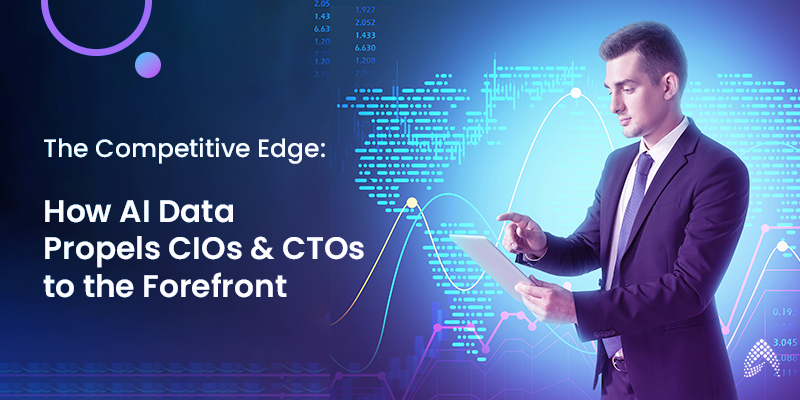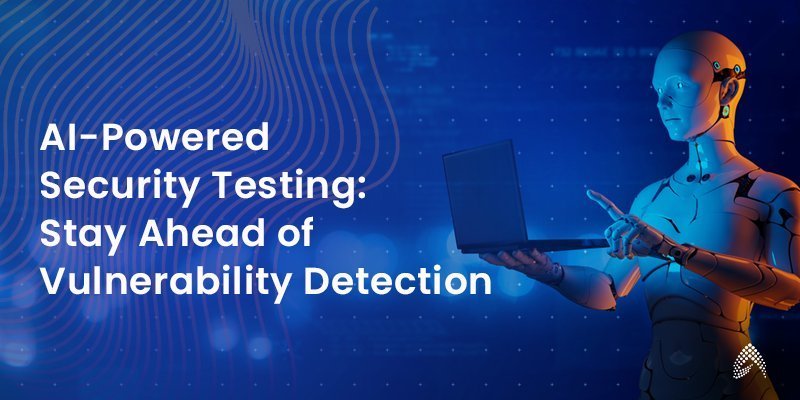The Competitive Edge: How AI Data Propels CIOs and CTOs to the Forefront

Welcome to the digital age, where data is not just a resource, but a game-changing factor in strategic decision-making. For CIOs and CTOs, harnessing the power of AI-driven data isn’t just an upgrade, it’s a must-have for staying ahead and streamlining operations. In this blog, we delve into five incredible capabilities where AI is revolutionizing the roles of CIOs and CTOs, igniting growth, and sparking innovation across industries.
This blog will explore the significance of AI-powered data for CIOs and CTOs embarking on a transformation journey.
5 Capabilities Unleashed: How AI-Powered Data Empowers CIOs and CTOs
1. Trend and Pattern Analysis:
Imagine you have to sift through mountains of customer reviews, social media mentions, and website analytics data to identify trends manually. It would be a time-consuming and erroneous process. This is where AI-powered data analysis comes in. By leveraging machine learning algorithms and natural language processing, AI can process vast amounts of data to uncover hidden patterns, trends, and customer behaviour that would be difficult for humans to detect.
Benefits for CIOs and CTOs:
- Data visualization tools translate the raw data patterns and trends into charts, graphs, and other visual formats, allowing CIOs and CTOs to make well-informed decisions.
- NLP allows AI to analyze textual data from various sources like customer reviews, social media posts, and surveys. It can extract sentiment, identify keywords, and even generate human-like text summaries of data trends. This enables CIOs and CTOs to develop and implement strategies that enhance customer experience, and higher satisfaction and loyalty.
- AI enables CIOs and CTOs to develop products and services that meet evolving customer needs by understanding customer preferences and sentiment through NLP and Predictive Analytics technologies.
- The sheer volume of data analysis can overwhelm IT teams. AI automates tedious data analysis tasks, freeing up valuable IT resources to focus on strategic initiatives and innovation.
Example:
Consider a retail company struggling with declined sales. AI-powered machine learning algorithms analyze purchase history, browsing behavior, and demographics to recommend products tailored to individual customer preferences, enhancing the overall customer experience. NLP analyzes customer reviews, social media posts, and surveys to identify customer pain points and areas for improvement in product features, service, or overall experience.
2. Enhanced Cybersecurity:
In today’s constantly changing cyber threat landscape, organizations face the daunting task of staying vigilant against evolving risks. Traditional security methods are no longer enough. It’s crucial to have an intelligent security system to anticipate and alert you to potential threats before they become catastrophic. Leveraging neural networks and machine learning is highly effective for identifying patterns and anomalies in data, providing essential capabilities for pinpointing security risks.
Benefits for CIOs and CTOs:
For CIOs, neural networks provide a robust tool for safeguarding an organization’s data integrity and privacy. This technology enhances security by preventing breaches and minimizing downtime, which is crucial for maintaining trust and compliance.
For CTOs, neural networks in cybersecurity mean they can ensure that the technological infrastructure is resilient against current threats and adaptable to evolving security challenges. This capability is essential for maintaining system stability and operational continuity.
Example:
User behavior analysis and insider threat detection involve user activity monitoring within an organization to identify suspicious or potentially harmful actions. RNN [Recurrent Neural Network] and GNN [Graph Neural Networks] can work together to model normal user behavior and detect deviations that may indicate an insider threat in this use case.
RNN analyzes user interactions, such as file access, login attempts, or data transfers, and learns to identify typical behavior patterns. GNN generates new data points based on the learned patterns, helping to create a more robust understanding of normal user behavior. The system can identify anomalies and flag potential insider threats by comparing real-time user activities to the expected behavior patterns generated by the GNN.
By using RNNs and GNNs, organizations can better understand how users behave and find potential insider threats more accurately and efficiently. This helps CIOs and CTOs protect their organization’s data and assets proactively.
3. Smart Cloud Resource Allocation:
Traditional cloud resource allocation methods such as manual scaling, resource reservation, or static provisioning have often proven cumbersome and fought with inefficiencies, resulting in significant financial waste and underutilization. Embracing AI-powered solutions, particularly through deep learning technologies, offers a transformative approach. These AI technologies meticulously analyze historical cloud resource utilization patterns, workloads, and real-time data, and enable you to forecast accurate cloud demands.
This predictive capability facilitates the automated scaling of cloud resources – according to real-time needs, ensuring optimal efficiency. By leveraging such AI-driven strategies, businesses can align their resource allocation more closely with actual requirements and eliminate unnecessary expenditures associated with over-provisioning.
Benefits for CIOs and CTOs:
CIOs gain greater visibility and control over cloud spend. AI proactively identifies underutilized resources, allowing them to optimize cloud costs and eliminate unnecessary expenses. Additionally, AI-powered scaling ensures the organization doesn’t incur charges for unused resources during periods of low demand.
CTOs can ensure optimal application performance by dynamically allocating resources based on user demand. AI-powered data helps proactively address potential bottlenecks and outages by scaling resources during peak workloads. This enhances user experience and minimizes the risk of service disruptions that can impact business operations.
Example:
If you are running a retail or eCommerce business, it often experiences a surge in website traffic during specific days. Hence, you need a dynamic cloud resource allocation mechanism to handle those spikes and deliver an exceptional customer experience.
AI-powred data helps in the automatic resource scaling (up during peak times, down during lulls) ensuring optimal performance without overspending. AI can also identify underutilized resources, allowing them to be downsized for further cost savings. Furthermore, big data technologies can help identify opportunities to downsize underutilized resources and optimize your cloud environment.
4. Enhanced Customer Insights:
Natural Language Processing is a cornerstone AI technology designed to dissect and interpret the human language to enhance customer insights. By deploying sophisticated NLP algorithms, businesses can analyze text from customer communications or feedback, effectively gauging the underlying sentiment – positive, negative, or neutral. These advanced analytical capabilities empower organizations to assess customer satisfaction accurately and address emerging issues or concerns.
Thus, NLP act as a critical tool in strategic business planning, aiming to maintain a pulse on customer perceptions and enhance service offerings.
Benefits for CIOs and CTOs:
CIO benefits from NLP by aligning IT infrastructure to support enhanced customer service platforms, ensuring systems can handle advanced data analysis and real-time customer interactions.
CTOs utilize this AI-powered data to guide product development and innovation, ensuring that new offerings or updates directly address customer needs and preferences, thereby maintaining a competitive advantage.
Example:
AI-powered Natural Language Processing has valuable applications beyond analyzing customer feedback. Consider the scenario where CIOs and CTOs are inundated with technical documentation, support tickets, and internal communication channels. NLP can proficiently process this extensive text data to discern patterns and potential issues. For instance, NLP can sift through bug reports and code comments, promptly highlighting recurring issues and identifying areas with significant error rates. This enables CIOs and CTOs to prioritize bug fixes, allocate resources effectively to development teams, and ultimately enhance software quality while reducing development time.
5. Disaster Recovery:
Predictive analytics is one of the emerging and most used technologies in CIOs and CTOs’ arsenal. By leveraging historical data and AI-powered machine learning algorithms, predictive analytics foresee and anticipate potential system failures or disruptions. This further helps businesses develop AI-powered disaster recovery plans, enabling them to respond swiftly and effectively.
AI systems predict a potential server overload during high transaction periods and automatically trigger preventive measures to redistribute the load, thereby limiting a major system failure. This proactive approach minimizes downtime and also ensures continuous service delivery, safeguarding the firm’s operational integrity and client trust.
Benefits for CIOs and CTOs:
For CIOs, the benefit lies in ensuring business continuity with minimal downtime. Predictive analytics enables them to maintain system availability and access to critical data during unforeseen disruptions, aligning disaster recovery strategies with overall business objectives.
For CTOs, this approach helps safeguard the technical infrastructure and data integrity, which is crucial for maintaining the operational capabilities of the technology stack and supporting ongoing innovation even during potential disasters.
Example:
Disasters can strike in many forms, and cloud outages are a major concern for CIOs and CTOs. Here’s where AI-powered predictive analytics steps in. These algorithms analyze historical data on cloud performance, server health, and even network traffic patterns.
Imagine a cloud server experiencing gradual performance degradation. The AI-powered predictive analytics can initiate a seamless switch to a redundant cloud instance, minimizing downtime and disruption to business operations. By predicting potential cloud failures, AI empowers CIOs and CTOs to take proactive steps and ensure a smooth disaster recovery process, safeguarding valuable data and minimizing downtime.
Make Intelligent Moves:
As we move forward, AI-powered data becomes a linchpin for all businesses across industries. CIOs and CTOs who embrace these powerful AI-powered tools are not just prepared for the challenges ahead but positioned to unlock unprecedented opportunities for growth, resilience, and leadership in the dynamic technology landscape.
Would you like to embrace AI and unlock new opportunities? Learn how to implement an AI strategy at scale for SMBs.

President & CEO – Growth Markets




